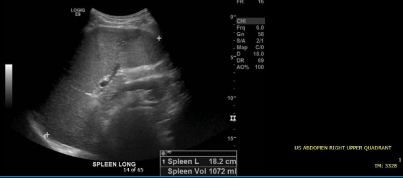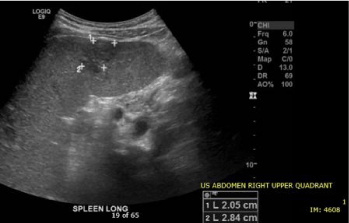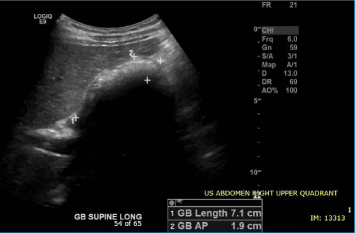
Case Report
J Blood Disord. 2020; 7(1): 1060.
Incidental Diagnosis of Adult Beta-Thalassemia with Point-of-Care Ultrasound in the Emergency Department: A Case Report
Dennis JL*, Morrow D and Cupp JA
University of South Carolina School of Medicine Greenville, USA
*Corresponding author: Dennis JL, School of Medicine, University of South Carolina School of Medicine Greenville, South Carolina, USA
Received: June 28, 2020; Accepted: July 24, 2020; Published: July 31, 2020
Abstract
Beta-thalassemia is an autosomal recessive hemoglobinopathy that can result in microcytic hypochromic anemia, splenomegaly, hypercoagulability, and long-term sequelae. Beta-thalassemia intermedia, specifically, is diagnosed by a moderate severity of illness, which does not carry the early symptomatic urgency of beta-thalassemia major, although patients of both often become chronically or intermittently transfusion-dependent. A presenting symptom may be splenomegaly, which is most efficiently detected with a combination of physical examination and Point-of-Care Ultrasound (POCUS).
We present the case of a 25-year-old patient with no significant past medical history who came to the emergency department for one week of abdominal discomfort. The history of present illness, review of systems, and physical exam were non revealing. An ultrasound was performed to rule out renal colic; however, he was incidentally found to have an enlarged and infarcted spleen. This unexpected discovery warranted a laboratory work-up which indicated beta-thalassemia intermedia. His diagnosis was confirmed with serum protein electrophoresis and he was thereafter followed by hematology.
Beta-thalassemia intermedia can present suddenly in adulthood, despite a benign past medical history. Splenomegaly may be a presenting symptom and can be effectively detected with physical exam plus POCUS. Failure to detect these subtleties can lead to potentially life-threatening conditions such as profound anemia, thromboembolic accidents, pulmonary hypertension, and pathological fractures. This case demonstrates the importance of utilizing POCUS in combination with physical examination to attain a comprehensive perspective of anatomy, even in those patients fast-tracked in the emergency department.
Keywords: Thalassemia; Beta-thalassemia; Ultrasound; Ultrasonography; POCUS; Splenomegaly; Emergency
Introduction
Beta-thalassemia is an autosomal recessive hemoglobinopathy caused by a mutation in one or both beta-globin loci in erythrocytes. This mutation can result in microcytic hypochromic anemia, splenomegaly, extramedullary hematopoiesis, hypercoagulability, gallstones, pathological fractures, iron overload, and/or pulmonary hypertension.
Beta-thalassemia intermedia is diagnosed by the severity of illness, which does not carry the symptomatic urgency of beta-thalassemia major, although both often become chronically or intermittently transfusion-dependent [1]. Those with beta-thalassemia intermedia often have a hemoglobin level ranging between 7 and 10 g/dL and become symptomatic during periods of systemic stress such as pregnancy, infection, or other illness [1].
Splenomegaly is a relatively early symptom of beta-thalassemia intermedia that is possibly detected by physical exam. However, physical examination of splenomegaly is more specific than sensitive and is best used to rule-in a diagnosis already suspected [2]. Since findings may be limited by body habitus, general anatomy, and physician experience, many physicians default to imaging such asultrasonography, computed tomography, or nuclear liver-spleen imaging [3].
Case Report
We present the case of a 25-year-old male with no reported significant past medical history that arrived at the emergency department, per the insistence of his girlfriend, with left-sided upper abdominal and back pain for one week. The pain, described as an “air bubble," was 6 out of 10 on the Numeric Rating Score of pain at its worst, alleviated by drinking water, and exacerbated by deep breathing. He initially attributed the discomfort to flatus from fried chicken, although simethicone had not improved the discomfort. He denied fever, weight loss, night sweats, nausea, vomiting, diarrhea, or dysuria. He also denied recent illness or travel.

Figure 1: Splenomegaly indicated by spleen length at 18.2 cm with splenic
volume of 1072 mL. For comparison, a normal spleen length is approximately
11 cm with a mean volume of 166 mL.

Figure 2: Splenic wedge-shaped hypoechogenic lesion, 2.05 x 2.84 cm,
indicative of absent blood flow in the periphery of the spleen due to infarction.
The patient-reported family history was notable for a brother with possible sickle cell trait and mother with anemia of unknown etiology. This family history prompted further questioning of the patient’s medical history, during which he did endorse having been told he had sickle cell trait, although he had never been tested nor received a transfusion.
The general impression of this man was a healthy-appearing young adult in mild to moderate abdominal discomfort with no worrisome signs, symptoms, or past medical history. The patient expressed minimal concern of his symptoms; however, his girlfriend insisted the abdominal pain was abnormal for him. Bedside Point-of-Care Ultrasound (POCUS) was utilized as a reassurance tool to exclude the presence of free fluid in the abdomen that might suggest a more serious cause of abdominal pain in the left upper quadrant. Unexpectedly, ultrasonography revealed splenomegaly (Figure 1) [4] with hypoechogenicity indicative of splenic infarcts.
This unexpected discovery suggested a pathologic, rather than functional, etiology of his abdominal pain and enabled the emergency physician to convince the patient to stay for further testing. Blood work revealed microcytic anemia, thrombocytopenia, hyperbilirubinemia, and a high reticulocyte count consistent with hemolysis (Supplementary Table 1). HIV antibody, heterophile antibody test, and fecal occult blood tests were negative. Laboratory tests pending at time of discharge that were also found to be negative included paroxysmal nocturnal hemoglobinuria, factor V Leiden mutation, and prothrombin 20210 mutation.

Figure 3: Gallbladder with multiple gallstones. Gallbladder length is within
normal limits at 7.1 cm.
A comprehensive radiology study was ordered, which confirmed the POCUS findings of pronounced splenomegaly with multifocal splenic infarcts, as well as uncomplicated cholelithiasis.
Due to his low hemoglobin of 6.9 g/dL, he was given one unit of packed red blood cells with an appropriate increase in his subsequent hemoglobin to 8.2 g/dL. Hematology was consulted, and a hypercoagulability and hemoglobinopathy work-up was performed. The patient was then discharged with prescriptions for cyanocobalamin tablets, folate tablets, and diphenhydramine for itching after his transfusion. He was advised to follow up with hematology outpatient for pending laboratory results, management of his presumed newfound thalassemia, and referral for iron chelation therapy.
Discussion
The serum laboratory evaluation of this patient was interpreted as a profoundly microcytic anemia with target cells, tear drop cells, and high reticulocyte count indicative of functional bone marrow compensation for extravascular hemolysis. Additionally, the decreased hemoglobin A1 (normal adult hemoglobin made of alpha- and beta- globin chains) with profoundly increased hemoglobin F (fetal hemoglobin made of alpha- and gamma- globin chains) and increased hemoglobin A2 (alternative adult hemoglobin made of alpha- and delta- globin chains) suggested a deficiency of beta-globin synthesis, further supporting a diagnosis of beta-thalassemia.
Beta-thalassemia intermedia, also known as non-transfusion-dependent thalassemia, was coined to describe clinical manifestations that are not severe enough to be classified as “major” yet often still require transfusions [1]. It is important to detect patients with beta-thalassemia intermedia as it is known to carry the comorbidity of hypercoagulability, with paradoxically increased predisposition for thrombosis compared to beta-thalassemia major, with risks including portal vein thrombosis, pulmonary embolism, and stroke [5]. Common symptoms of beta-thalassemia intermedia are thrombophilia, extramedullary hematopoiesis, cholelithiasis, and splenomegaly [6]; all of which were experienced by this patient.
One of the most important aspects of this case was abdominal pain, which was likely attributed to splenic infarcts from his hypercoagulable state, and splenomegaly from hemolysis and extramedullary hematopoiesis. Traditionally, physicians have been taught to screen for anemia or splenomegaly, both potential associations with abdominal pain, by physical examination. However, these examinations alone do not lend themselves to be reliable screening tools. Pertaining to anemia physical examination findings, it has been concluded that the absence of pallor does not rule out anemia and is, therefore, not useful in ruling out suspicious diagnoses. In a study by Nardone et al. pallor at the conjunctiva, face, or palms yielded unconvincing sensitivities ranging from 0.53-0.65. Pallor of all three anatomic sites together yielded a specificity of 0.95, which could be used to confirm anemia, albeit not a consistently useful diagnostic tool [7]. Pertaining to splenomegaly physical examination findings, results are often limited by body habitus, physician experience, or anatomical variations. Physical examination of splenomegaly is more specific than sensitive and is best used to rule in a diagnosis. For greater confidence in detecting splenomegaly on physical examination, Simel et al. suggested using Traube space percussion, followed by supine one-handed palpation which may be superior to percussion in lean patients [3]. For the most reliable detection of splenomegaly, a combination of physical examination and POCUS demonstrated a strong sensitivity of 100%, while physical examination alone was determined to have a sensitivity of only 40% [2]. Thus, it can be concluded that a patient suspected of suffering from splenomegaly should receive percussion, palpation, and POCUS of the abdominal left upper quadrant.
Abdominal pain is the most common single complaint prompting visits to the emergency department, accounting for 7% of visits in one year [8]. Abdominal pain poses a challenge for physicians, as the severity and clinical consequences of potential etiologies is vast. Amidst these frequent and variable complaints, splenomegaly is an important diagnosis to make, although it can be subtle and difficult to detect with history and physical exam alone. Splenomegaly is indicative of a broad range of potentially clinically significant underlying pathology such as beta-thalassemia intermedia seen in this patient. Beta-thalassemia intermedia is an example of a rare disease that may present in healthy older children or adults and can have fatal consequences if not detected, such as profound anemia, thromboembolic accidents, pulmonary hypertension, and pathological fractures. This case demonstrates the importance of utilizing both physical examination and POCUS together in patients suspected of splenic pathology, even in those fast-tracked in the emergency department.
References
- Musallam KM, Taher AT, Rachmilewitz EA. β-thalassemia intermedia: a clinical perspective. Cold Spring Harb Perspect Med. 2012; 2: a013482.
- Olson APJ, Trappey B, Wagner M, Newman M, Nixon LJ, Schnobrich D. Point-of-care ultrasonography improves the diagnosis of splenomegaly in hospitalized patients. Critical Ultrasound Journal. 2015; 7.
- Simel DL, Rennie DA, Keitz Sun defined. The Rational Clinical Examination: Evidence-Based Clinical Diagnosis. New York: McGraw-Hill. 2009.
- Chow KU, Luxembourg B, Seifried E, Bonig H. Spleen Size Is Significantly Influenced by Body Height and Sex: Establishment of Normal Values for Spleen Size at US with a Cohort of 1200 Healthy Individuals. Radiology. 2015; 279: 306-313.
- Taher AT, Otrock ZK, Uthman I, Cappellini MD. Thalassemia and hyper coagulability. Blood Reviews. 2008; 22: 283-292.
- Taher A, Ismaeel H, Cappellini MD. Thalassemia intermedia: Revisited. Blood Cells, Molecules, and Diseases. 2006; 37: 12-20.
- Nardone DA, Roth KM, Mazur DJ, McAfee JH. Usefulness of Physical Examination in Detecting the Presence or Absence of Anemia. Arch Intern Med. 1990; 150: 201-204.
- Pitts SR, Niska RW, Xu J, Jianmin Xu, Catharine W Burt. National hospital ambulatory medical care survey: 2006 emergency department summary. National health statistics report; no 7. Hyattsville, MD: National Center for Health Statistics. 2008; 7: 1-38.